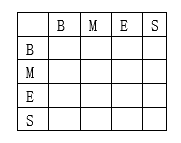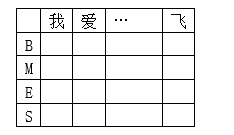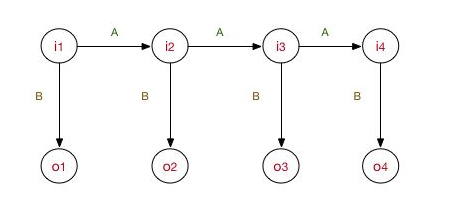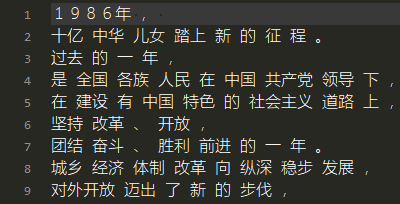1, HMM word segmentation idea
HMM implements word segmentation as a sequence annotation task of words in a string.
The basic idea is that each word occupies a certain word formation position (i.e. word position) when constructing a specific word. It is stipulated that each word can only have four word formation positions at most, i.e
B
B
B (initial word)
M
M
M (in words)
E
E
E (suffix) and
S
S
S (separate word).
2, HMM model construction
1. Model state set
Q Q Q = { B B B, M M M, E E E, S S S}, N N N = 4
2. Observation state set
V V V = { I I I, love love Love,...}, a collection of sentences.
3. Observe the status and status sequence
Observation sequence: Xiao Ming is Chinese
Status sequence:
B
,
E
,
S
,
B
,
M
,
E
B, E, S, B, M, E
B,E,S,B,M,E
4. State transition probability distribution matrix
In Chinese word segmentation, it is the sequence of states
Q
Q
Q = {
B
B
B,
M
M
M,
E
E
E,
S
S
S} The state probability matrix is obtained in the parameter estimation in the training stage.

5. Observation state probability matrix (launch probability)
In Chinese word segmentation, the emission probability refers to the state sequence corresponding to each character
Q
Q
Q = {
B
B
B,
M
M
M,
E
E
E,
S
S
S} The probability of each state in the training set is obtained by counting the frequency of the corresponding state of each character in the training set.

6. Initial probability
In Chinese, the initial state probability of word segmentation refers to the corresponding state probability of the first character of each sentence.
{
B
B
B: xxx,
M
M
M: xxx,
E
E
E: xxx,
S
S
S: xxx}
7. Objectives

max =
m
a
x
P
(
i
1
,
i
2
,
i
3
.
.
.
,
i
T
∣
o
1
,
o
2
,
o
3
.
.
.
,
o
T
)
maxP(i_1, i_2, i_3...,i_T | o_1,o_2,o_3... ,o_T)
maxP(i1,i2,i3...,iT∣o1,o2,o3...,oT)
Of which:
T
T
T is the length of the sentence,
o
i
o_i
oi is every word of the sentence,
i
i
i_i
ii) is the mark of each word.
According to Bayesian formula:

P
(
i
∣
o
)
P(i | o)
P(i∣o) =
P
(
o
∣
i
)
P
(
o
)
P(o | i) P(o)
P(o∣i)P(o) /
P
(
i
)
P(i)
P(i)
According to homogeneity HMM:
P
(
o
)
=
p
(
o
1
)
p
(
o
2
∣
o
1
)
.
.
.
p
(
o
t
∣
o
t
−
1
)
P(o) = p(o1)p(o_2| o_1)...p(o_{t}| o_{t-1})
P(o)=p(o1)p(o2∣o1)... p(ot ∣ ot − 1), state transition probability.
P
(
o
∣
i
)
=
p
(
o
1
∣
i
1
)
.
.
.
p
(
o
t
∣
i
t
)
P(o | i) = p(o_1| i_1)...p(o_{t}| i_{t})
P(o∣i)=p(o1∣i1)... p(ot ∣ it), that is, the probability of generating the observation state (transmission probability).
send P ( o ) P ( o ∣ i ) P(o) P(o | i) P(o)P(o ∣ i) has the highest probability.
3, Corpus
In the people's daily corpus, each line is a sentence, and each word is separated by a space.

IV python code implementation
1. Initialization class
class HMM(object):
def __init__(self):
# It is mainly used to access the intermediate results of the algorithm without training the model every time
self.model_file = './data/hmm_model.pkl'
# Status value set
self.state_list = ['B', 'M', 'E', 'S']
# Parameter loading is used to determine whether the model needs to be reloaded_ file
self.load_para = False
# Count the occurrence times of the status, and find p(o)
self.Count_dic = {}
# Count the expected total number of rows
self.line_num = 0
2. Decide whether to retrain
def try_load_model(self, trained):
"""
It is used to load the calculated intermediate results. When it is necessary to retrain, it is necessary to initialize the emptying results
:param trained: Training or not
:return:
"""
if trained:
with open(self.model_file, 'rb') as f:
self.A_dic = pickle.load(f)
self.B_dic = pickle.load(f)
self.Pi_dic = pickle.load(f)
self.load_para = True
else:
# State transition probability (State - > conditional probability of state)
self.A_dic = {}
# Launch probability (status - > conditional probability of words)
self.B_dic = {}
# Initial probability of state
self.Pi_dic = {}
self.load_para = False
3. Initialization parameters
def init_parameters(self):
"""
Initialization parameters
:return:
"""
for state in self.state_list:
self.A_dic[state] = {s: 0.0 for s in self.state_list}
self.Pi_dic[state] = 0.0
self.B_dic[state] = {}
self.Count_dic[state] = 0
4. Mark the input sentences
@staticmethod
def make_label(text):
"""
Put words according to B,M,E,S tagging
B: prefix
M: In words
E: Suffix
S: Separate word formation
:param text:
:return:
"""
out_text = []
if len(text) == 1:
out_text.append('S')
else:
out_text += ['B'] + ['M'] * (len(text) - 2) + ['E']
return out_text
5. Training
def train(hmm, path):
# Set of observers, mainly words and punctuation
words = set()
line_num = -1
with open(path, encoding='utf8') as f:
for line in f:
line_num += 1
line = line.strip()
if not line:
continue
# Gets the word for each line and updates the set of words
word_list = [i for i in line if i != ' ']
words |= set(word_list)
# Each line is segmented according to the space and the result of word segmentation
line_list = line.split()
line_state = []
for w in line_list:
line_state.extend(hmm.make_label(w))
assert len(word_list) == len(line_state)
# ['B', 'M', 'M', 'M', 'E', 'S']
for k, v in enumerate(line_state):
hmm.Count_dic[v] += 1 # Count the number of occurrences of the status
if k == 0:
hmm.Pi_dic[v] += 1 # The state of the first word of each sentence is used to calculate the initial state probability
else:
# {'B': {'B': 0.0, 'M': 0.0, 'E': 0.0, 'S': 0.0}, ...}
# A matrix update: the second state "M", get the previous state "B", B - > M: add one
# {'B': {'B': 0.0, 'M': 1.0, 'E': 0.0, 'S': 0.0}, ...}
hmm.A_dic[line_state[k - 1]][v] += 1 # Calculate transition probability
# {'B': {}, 'M': {}, 'E': {}, 'S': {}}
# ['1', '9', '8', '6', 'year', 'year', ']
# {'B': {}, 'M': {'9': 1.0}, 'E': {}, 'S': {}}
hmm.B_dic[line_state[k]][word_list[k]] = hmm.B_dic[line_state[k]].get(word_list[k], 0) + 1.0 # Calculate launch probability
hmm.line_num = line_num
# A_dic
# {'B': {'B': 0.0, 'M': 162066.0, 'E': 1226466.0, 'S': 0.0},
# 'M': {'B': 0.0, 'M': 62332.0, 'E': 162066.0, 'S': 0.0},
# 'E': {'B': 651128.0, 'M': 0.0, 'E': 0.0, 'S': 737404.0},
# 'S': {'B': 563988.0, 'M': 0.0, 'E': 0.0, 'S': 747969.0}
# }
# B_dic
# {'B': {'medium': 12812.0, 'son': 464.0, 'step': 62.0},
# 'M ': {' medium ': 12812.0,' son ': 464.0,' step ': 62.0},
# 'E': {'medium': 12812.0, 'son': 464.0, 'step': 62.0},
# 'S': {'medium': 12812.0, 'son': 464.0, 'step': 62.0},
# }
# Count_dic: {'B': 1388532, 'M': 224398, 'E': 1388532, 'S': 1609916}
calculate_probability(hmm)
# Calculate probability
def calculate_probability(hmm):
# Finding probability
hmm.Pi_dic = {k: v * 1.0 / hmm.line_num for k, v in hmm.Pi_dic.items()}
# Probability of transition state
hmm.A_dic = {k: {k1: v1 / hmm.Count_dic[k] for k1, v1 in v.items()} for k, v in hmm.A_dic.items()}
# 1 plus smoothing
hmm.B_dic = {k: {k1: (v1 + 1) / hmm.Count_dic[k] for k1, v1 in v.items()} for k, v in hmm.B_dic.items()}
with open(hmm.model_file, 'wb') as f:
pickle.dump(hmm.A_dic, f)
pickle.dump(hmm.B_dic, f)
pickle.dump(hmm.Pi_dic, f)
6. Viterbi algorithm annotation, word segmentation according to annotation
def viterbi(self, text, states, start_p, trans_p, emit_p):
V = [{}]
path = {}
for y in states:
V[0][y] = start_p[y] * emit_p[y].get(text[0], 0)
path[y] = [y]
for t in range(1, len(text)):
V.append({})
newpath = {}
# Check whether there is this word in the transmission probability matrix of training
neverSeen = text[t] not in emit_p['S'].keys() and \
text[t] not in emit_p['M'].keys() and \
text[t] not in emit_p['E'].keys() and \
text[t] not in emit_p['B'].keys()
for y in states:
emitP = emit_p[y].get(text[t], 0) if not neverSeen else 1.0 # Set unknown words to separate words
(prob, state) = max(
[(V[t - 1][y0] * trans_p[y0].get(y, 0) *
emitP, y0)
for y0 in states if V[t - 1][y0] > 0])
V[t][y] = prob
newpath[y] = path[state] + [y]
path = newpath
if emit_p['M'].get(text[-1], 0) > emit_p['S'].get(text[-1], 0):
(prob, state) = max([(V[len(text) - 1][y], y) for y in ('E', 'M')])
else:
(prob, state) = max([(V[len(text) - 1][y], y) for y in states])
return prob, path[state]
def cut(self, text):
import os
if not self.load_para:
self.try_load_model(os.path.exists(self.model_file))
prob, pos_list = self.viterbi(text, self.state_list, self.Pi_dic, self.A_dic, self.B_dic)
begin, next = 0, 0
for i, char in enumerate(text):
pos = pos_list[i]
if pos == 'B':
begin = i
elif pos == 'E':
yield text[begin: i + 1]
next = i + 1
elif pos == 'S':
yield char
next = i + 1
if next < len(text):
yield text[next:]
7. Test
if __name__ == '__main__':
hmm = HMM()
hmm.try_load_model(True)
# Initialize state transition matrix
hmm.init_parameters()
# print(hmm.A_dic)
# print(hmm.B_dic)
# print(hmm.Pi_dic)
train(hmm, './data/trainCorpus.txt_utf8')
text = 'This is a great plan!'
res = hmm.cut(text)
print(text)
print(str(list(res)))
8. Results
